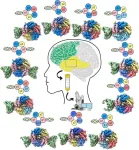(Press-News.org) The magnitude 7.9 Bonin Islands earthquake sequence, which ruptured deep within the earth near the base of the upper mantle, did not include an aftershock that extended to record depths into the lower mantle, according to a study in The Seismic Record.
When Hao Zhang of the University of Southern California and colleagues re-examined the aftershock sequence of the May 2015 earthquake, they did not find evidence for a 751-kilometer-deep aftershock as reported by previous researchers. This aftershock has been called the deepest earthquake ever recorded.
Instead, their study found a distribution of aftershocks that is compatible with a 12-kilometer sliver of a mantle mineral called olivine that could shed light on how deep earthquakes can occur.
The Bonin Islands earthquake, which ruptured 1000 kilometers offshore of Japan in a remote part of the Pacific Ocean, is one of the deepest and largest earthquakes ever recorded. The earthquake took place within the Izu-Bonin subduction zone 680 kilometers below the Earth’s surface.
The mechanisms behind deep earthquakes—those occurring 500 kilometers or deeper—are something of a mystery to seismologists. Extremely high pressures and temperatures at these depths make rock more likely to bend or deform plastically, rather than break in the brittle fashion that causes earthquake rupture at shallower depths.
These earthquakes also typically produce few aftershocks, Zhang noted, which could provide useful data to understand how these deep events are generated at subduction zones.
Plastic deformation “limits the formation of extensive fracture networks that would typically generate aftershocks,” he said. “Additionally, the high confining pressures promote efficient redistribution of stress following the mainshock, further reducing the likelihood of subsequent seismic events.”
One previous study of the Bonin Islands earthquake reported a foreshock sequence for the event, while a second study detected a potentially record-breaking deep aftershock in the lower mantle.
“Both findings could significantly advance our understanding of deep earthquakes, if accurate,” said Zhang. “However, these two catalogs are inconsistent, and both have methodological limitations. Therefore, it is essential to re-examine the aftershock sequence using improved techniques.”
To gain a better look at the deep and remote earthquake, Zhang and colleagues turned to data collected by a dense seismic array in Japan called Hi-Net, using a combination of techniques to precisely locate seismic signals coming from the event.
Their new analysis detected no foreshocks but identified 14 aftershocks in the upper mantle within a 150-kilometer radius of the earthquake’s hypocenter. One set of aftershocks aligned with the rupture plane of the earthquake one week after the mainshock, with a second set dispersing over a wider area during the second week.
“While it remains challenging to definitely reject the existence of seismicity initiated in the lower mantle and its associated mechanisms, our results do reject the most compelling lower mantle seismicity claim to date,” the researchers write in their paper.
The aftershock pattern is compatible with the presence of a metastable olivine wedge or MOW, the researchers suggested. In a subducting slab, olivine can delay its transition into other mineral states under high temperature and pressure. “This delayed transformation may generate stress and release energy, potentially triggering deep earthquakes,” Zhang said.
With MOWs as potential earthquake nucleation sites, some researchers have proposed this mechanism of transformational faulting as one of the main ways that deep earthquakes occur, he added.
“Furthermore, MOWs offer insights into the thermal structure and behavior of subducting slabs, with colder slabs being more likely to preserve metastable olivine at greater depths,” Zhang added. “By studying MOWs, we can refine models of deep earthquake generation and improve our understanding of the dynamic processes in Earth’s interior.”
END
Claims for the world’s deepest earthquake challenged by new analysis
2025-01-22
ELSE PRESS RELEASES FROM THIS DATE:
MSU study finds children of color experience more variability in sleep times
2025-01-22
MSU has a satellite uplink/LTN TV studio and Comrex line for radio interviews upon request.
EAST LANSING, Mich. – Researchers from Michigan State University’s Department of Human Development and Family Studies revealed that sleep patterns may vary across different racial and ethnic groups — notably for non-white and multiracial children.
Yijie Wang is an associate professor of human development and family studies in the College of Social Science, and her research team published a ...
Pregnancy may increase risk of mental illness in people with MS
2025-01-22
MINNEAPOLIS — Pregnant people with multiple sclerosis (MS) have a higher chance of experiencing mental illness both during their pregnancy and in the first years after they give birth than those without MS, according to a study published in the January 22, 2025 online issue of Neurology®, the medical journal of the American Academy of Neurology.
“Previous studies have shown that women with MS are more likely to have depression, anxiety disorders and bipolar disorder compared to women without MS,” said study author Ruth Ann Marrie, MD, PhD, of Dalhousie University in Halifax, Canada, and ...
Multiple sclerosis linked to higher risk of mental illness during and after pregnancy
2025-01-22
Toronto, ON, January 22, 2025 – People with multiple sclerosis (MS) face a significantly higher risk of perinatal mental illness compared to those with other chronic conditions, according to a new study analyzing over 890,000 births in Ontario.
The research, published online in Neurology, the medical journal of the American Academy of Neurology, sheds light on the mental health challenges faced by people with MS during pregnancy and the first year after childbirth. Using population-based health ...
Beyond ChatGPT: WVU researchers to study use and ethics of artificial intelligence across disciplines
2025-01-22
Two West Virginia University researchers have designed a curriculum to engage liberal arts faculty in discussions on the social, ethical and technical aspects of artificial intelligence and its role in classrooms.
Through a grant from the National Endowment for the Humanities, Erin Brock Carlson, assistant professor of English, and Scott Davidson, professor of philosophy, both at the WVU Eberly College of Arts and Sciences, have designed an interdisciplinary, cross-institutional program to facilitate conversations among faculty about the ...
Ultrasensitive test detects, serially monitors intact virus levels in patients with COVID-19
2025-01-22
Investigators from Mass General Brigham have found that a method originally designed for cancer detection can also identify and monitor even tiny amounts of SARS-CoV-2 intact viral particles in blood and other fluids from patients with acute COVID-19 infections, creating the potential for guiding future treatment of patients. The research is published in Science Advances.
“During the early days of the pandemic, we wanted to see if our approach for isolating small cancer vesicles could be adapted to isolate SARS-CoV-2 virus from biofluids like blood, stool, and ...
mRNA-activated blood clots could cushion the blow of osteoarthritis
2025-01-22
MADISON — University of Wisconsin–Madison researchers have developed a promising technique for treating osteoarthritis using therapeutic blood clots activated by messenger RNA.
Osteoarthritis is the most common form of arthritis, affecting roughly 33 million adults in the United States, according to the Centers for Disease Control and Prevention. It occurs when cartilage in key joints like the knees and hips deteriorates, causing pain and stiffness and impeding mobility.
In a paper in the journal Bioactive Materials ...
Three rockets will ignite Poker Flat’s 2025 launch season
2025-01-22
Three NASA sounding rockets are set to launch from Poker Flat Research Range as early as Tuesday to learn more about three types of aurora — black, flickering and fast-pulsating.
The launch window is Jan. 21 through Feb. 5.
The University of Alaska Fairbanks Geophysical Institute owns Poker Flat, located at Mile 30 Steese Highway, and operates it under a contract with NASA’s Wallops Flight Facility, part of the agency’s Goddard Space Flight Center.
The launches will be the first of the season. As of April 2024, Poker Flat had launched 350 major sounding rockets and ...
Jared M. Kutzin, DNP, MS, MPH, RN, named President of the Society for Simulation in Healthcare
2025-01-22
The Society for Simulation in Healthcare (SSH) has named Jared M. Kutzin, DNP, MS, MPH, RN, the Senior Director of the Simulation Teaching and Research (STAR) Center at The Mount Sinai Hospital, as its new President. He was elected this month during the annual International Meeting on Simulation in Healthcare (IMSH) in Orlando, Florida. He is the first Mount Sinai faculty member to hold this position and will serve as the 20th President of SSH.
Health care simulation is the practice of using immersive and innovative technology in ...
PET probe images inflammation with high sensitivity and selectivity
2025-01-22
Study Title: CD45-PET is a robust, non-invasive tool for imaging inflammation
Publication: Nature, January 22, 2025
Dana-Farber Cancer Institute authors: Ali Salehi Farid, PharmD, Jennifer E. Rowley, Harris H. Allen, Isabella G. Kruger, Soheil Tavakolpour, Kyle Neeley, Min Cong, PhD, Haneyeh Shahbazian, MD, Niki Dorafshani, Achraf Berrada, MS, Mohammad Rashidian, PhD
Summary: Researchers at Dana-Farber Cancer Institute have developed a breakthrough method to detect inflammation in the body using positron emission tomography (PET) imaging. This innovative probe targets CD45, a marker abundantly expressed on all immune cells but absent from other cell types. ...
Epilepsy patient samples offer unprecedented insights on brain ‘brakes’ linked to disorders
2025-01-22
Certain proteins found in the human brain have long been known to be critical to controlling how brain cells communicate with each other. So-called GABAA receptors are proteins that control the flow of ions into and out of cells. As they play such a vital role in how neurons slow down or stop firing, they have become the targets of many drugs for conditions such as epilepsy, anxiety, depression and insomnia.
Yet due to technical limitations and the delicate nature of studying human brain tissue, scientists have lacked a complete picture of how GABAA receptors, and their 19 subunits, ...



